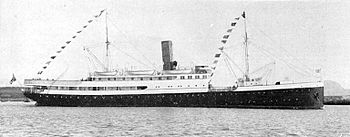SS Sanct Svithun
 |
|
| History | |
|---|---|
|
|
|
| Name: | Sanct Svithun |
| Namesake: | Saint Swithun – patron saint of Stavanger, Norway |
| Owner: | Det Stavangerske Dampskibsselskab in Stavanger |
| Port of registry: | Stavanger |
| Route: | Hurtigruten |
| Builder: | Danziger Werft, Free City of Danzig |
| Yard number: | 46 |
| Launched: | March 1927 |
| Acquired: | 1 July 1927 |
| Homeport: | Bergen, Norway |
| Fate: | Sunk by Allied aircraft on 30 September 1943 |
| General characteristics | |
| Tonnage: | 1,376 GRT |
| Length: | 236 ft (71.93 m) |
| Beam: | 35.2 ft (10.73 m) |
| Draught: | 21.3 ft (6.49 m) |
| Propulsion: | 1,650 hp 4 cylinder Lentz-type double compound engine |
| Speed: | 14 knots (26 km/h) |
| Capacity: | 100 First Class, 82 Third Class |
| Armament: | After 1940: German-manned anti-aircraft guns |
SS Sanct Svithun was a 1,376 ton steel-hulled steamship built by the German shipyard Danziger Werft and delivered to the Norwegian Stavanger-based shipping company Det Stavangerske Dampskibsselskab on 1 July 1927. She sailed the Hurtigruten route along the coast of Norway until she was lost in an air attack on 30 September 1943 during the Second World War.
Sanct Svithun was built for the Norwegian shipping company Det Stavangerske Dampskibsselskab by Danziger Werft in the Free City of Danzig in 1927, with yard number 46. She was launched in March, and delivered on 1 July 1927. She was rated at 1,376 gross register tons, measured 236 ft (71.93 m) in length, had a beam of 35.2 ft (10.73 m) and a draught of 21.3 ft (6.49 m). Her 1,650 hp 4 cylinder Lentz-type double compound engine could propel the ship at 14 knots (26 km/h). She was certified to take 100 First Class and 82 Third Class passengers.Sanct Svithun was named after Saint Swithun – the patron saint of Stavanger.
After her delivery from the Free City of Danzig Sanct Svithun was employed on the passenger/freight line between Bergen in Western Norway and various ports in Northern Norway. In 1931 she was rebuilt with a refrigerated cargo hold to enable her to transport fresh fish from the fisheries in Northern Norway. During the rebuild she was also fitted with wireless telegraphy. She was a popular ship amongst her passengers, with a large superstructure and a spacious promenade deck with a look-out salon in the bow area. Sanct Svithun was also known as a superbly seaworthy vessel.
...
Wikipedia
